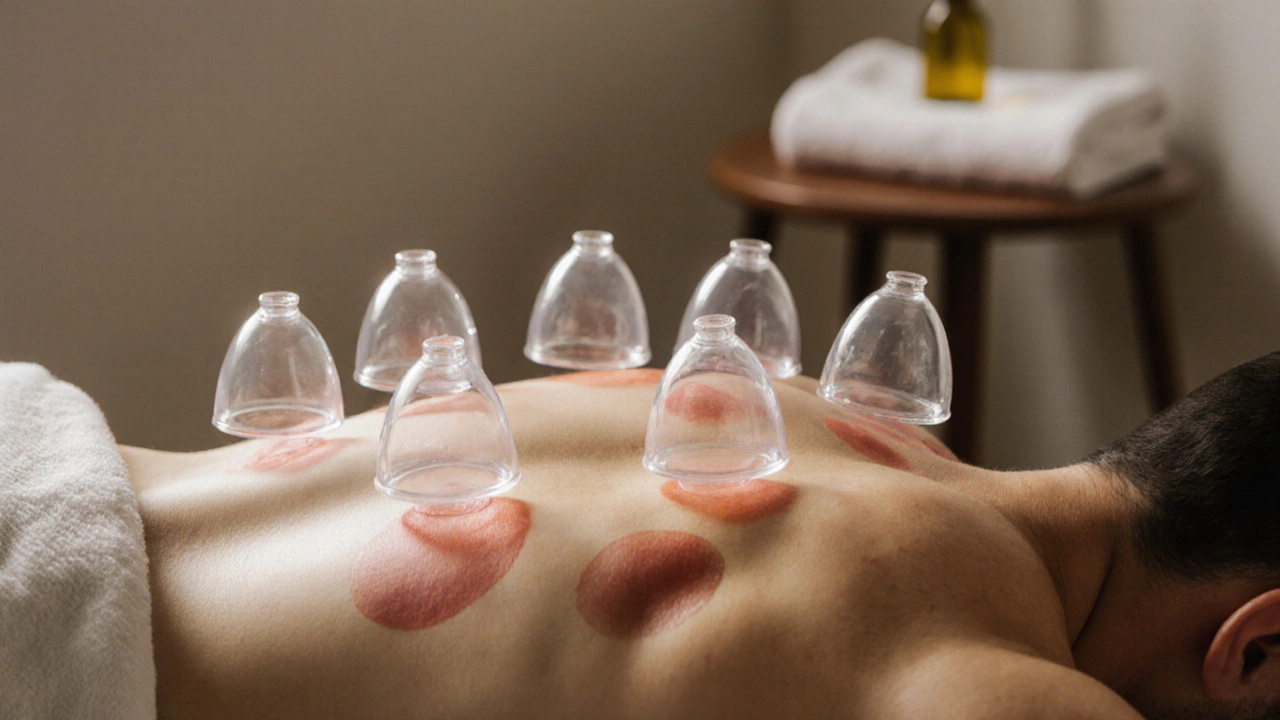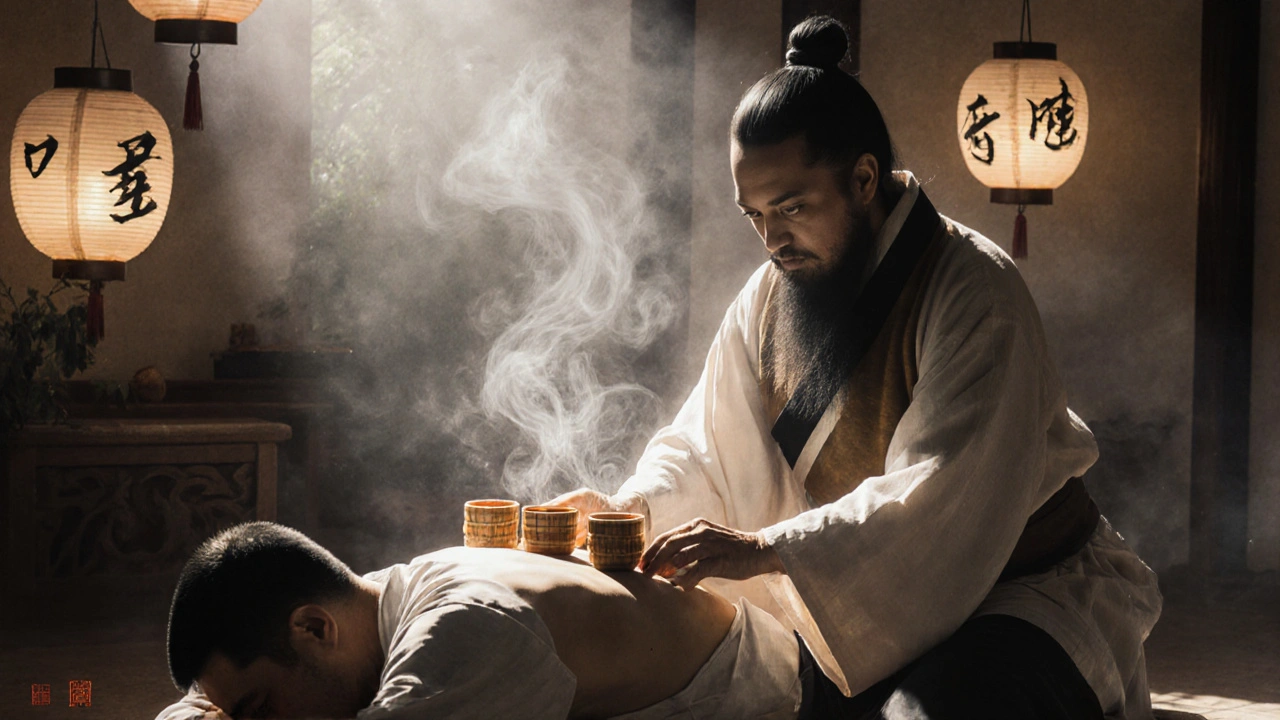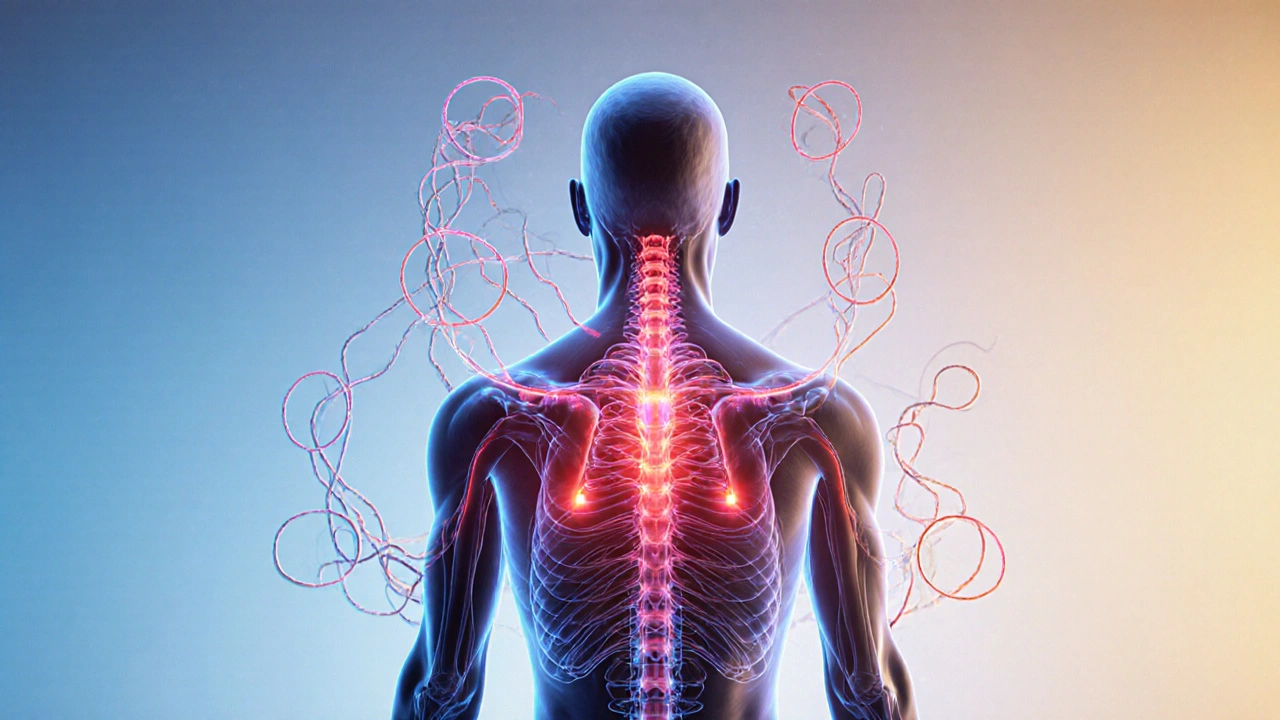Cupping Therapy: How This Ancient Practice Supports a Healthy Lifestyle
 Nov, 15 2025
Nov, 15 2025
Cupping Therapy Session Calculator
Get personalized recommendations for your cupping therapy sessions based on your condition and goals.
Ever seen someone with circular bruises on their back and wondered what happened? Those aren’t from a bad fall-they’re from cupping therapy, an ancient healing method that’s making a serious comeback. It’s not magic. It’s not a scam. And it’s not just for athletes anymore. Thousands of people in New Zealand, the U.S., and across Asia are using cupping to manage chronic pain, reduce stress, and feel more in tune with their bodies. If you’ve tried massage, acupuncture, or even yoga and still feel stuck, cupping might be the missing piece.
What Exactly Is Cupping Therapy?
Cupping therapy involves placing special cups-usually made of glass, silicone, or bamboo-on your skin. A vacuum is created inside the cup, pulling the skin and underlying tissue upward. This suction increases blood flow to the area, loosens tight muscles, and may help flush out metabolic waste. The cups stay on for 5 to 15 minutes. When removed, they leave behind round, reddish or purple marks that fade in a few days to a week.
It’s not new. Ancient Egyptians used it over 3,500 years ago. Traditional Chinese Medicine adopted it as a way to move qi (energy) and clear blockages. In the Middle East, it’s called hijama and often includes light bloodletting. Today, modern practitioners use dry cupping (no blood) or wet cupping (with tiny incisions), depending on the goal.
Think of it like a reverse massage. Instead of pressing down, the cups lift. That gentle pull creates space between muscle layers, which can ease tension you didn’t even know you were holding.
How Cupping Works on Your Body
The science behind cupping isn’t fully understood, but researchers have started to uncover what’s happening under the skin. A 2018 review in the Journal of Traditional and Complementary Medicine found that cupping triggers local inflammation-a controlled, short-term response that signals the body to send healing cells to the area. More blood flows in. White blood cells and oxygen increase. The lymphatic system gets a boost.
It also affects the nervous system. The suction stimulates sensory nerves under the skin, which can interrupt pain signals traveling to your brain. That’s why people with chronic lower back pain, neck stiffness, or headaches often report feeling relief after just one session.
It’s not just about muscles. Cupping helps with fascia-the connective tissue that wraps around every muscle, organ, and nerve. When fascia gets stuck from injury, stress, or sitting too long, it pulls on everything around it. Cupping gently releases that grip, improving mobility and reducing referred pain.
Who Uses Cupping and Why?
You might think cupping is only for Olympic athletes like Michael Phelps or Simone Biles, but that’s just the tip of the iceberg. In Wellington, I’ve seen teachers, nurses, office workers, and even grandparents use it regularly.
- People with chronic pain: Lower back pain, sciatica, and arthritis respond well. One 2021 study in BMJ Supportive & Palliative Care showed cupping reduced pain scores by 40% in patients with osteoarthritis after eight sessions.
- Stressed-out professionals: If your shoulders feel like they’re fused to your ears, cupping can break the cycle of tension. It activates the parasympathetic nervous system-the part that says, “You’re safe now.”
- Those with respiratory issues: Cupping on the upper back is used in some clinics to help with bronchitis, asthma, and even lingering colds. The suction helps loosen mucus and improve lung expansion.
- People recovering from injury: After a sprain or strain, circulation slows. Cupping speeds up healing by bringing fresh blood to damaged tissue.
It’s not a cure-all. But for people who’ve tried painkillers, physical therapy, or chiropractic care without lasting results, cupping often offers something different: a sense of release.
The Real Benefits: What Science Says
Let’s cut through the hype. Cupping isn’t going to cure cancer or reverse diabetes. But here’s what peer-reviewed studies show it can do:
- Reduces muscle soreness: A 2020 trial with 60 athletes found those who got cupping after intense training reported 30% less soreness than the control group.
- Improves range of motion: In a 2022 study on desk workers with neck pain, cupping improved head rotation by 22% after four weeks.
- Lowers cortisol: One small study in Iran found cortisol levels dropped by an average of 21% after a single cupping session-meaning less stress hormone circulating in your body.
- May help with migraines: A 2023 randomized trial showed cupping reduced migraine frequency by nearly half over eight weeks, comparable to some preventive medications.
These aren’t placebo effects. The changes are measurable. The marks aren’t just cosmetic-they’re evidence your body is responding.

What to Expect During a Session
First-time clients often worry about pain. The truth? Most people describe it as a deep, odd kind of comfort. It’s not painful, but it’s definitely noticeable.
A typical session lasts 30 to 45 minutes. You’ll lie face down or sit comfortably. The practitioner will apply oil or lotion to help the cups glide. Then they’ll place the cups on targeted areas-usually your back, shoulders, neck, or legs. The suction is adjusted based on your tolerance. You might feel a pulling, tingling, or warmth. Some people fall asleep.
Afterward, you might feel a little lightheaded or relaxed-like after a deep massage. Drink water. Avoid cold showers or heavy exercise for the next few hours. The marks are normal. They’re not bruises in the traditional sense; they’re areas of concentrated blood flow. They fade faster if you’re hydrated and active.
Who Should Avoid Cupping?
Cupping is safe for most people-but not everyone.
- Avoid if you have: Open wounds, severe skin conditions like eczema or psoriasis, or blood disorders like hemophilia.
- Use caution if you’re: Pregnant (especially on the abdomen or lower back), on blood thinners, or have a pacemaker.
- Don’t do it if you’re: Feeling sick with a fever, or just had surgery within the last six weeks.
Always tell your practitioner about your medical history. A good one will ask you. A bad one won’t. Trust your gut.
Cupping vs. Other Therapies
How does cupping stack up against massage, acupuncture, or foam rolling?
| Therapy | Best For | Duration of Relief | Side Effects |
|---|---|---|---|
| Cupping | Deep tissue tension, fascia release, circulation | 3-7 days | Temporary marks, mild soreness |
| Massage | Superficial muscle relaxation, stress relief | 1-3 days | Occasional soreness |
| Acupuncture | Nerve pain, hormonal balance, internal organ function | Weeks to months | Minor bruising, rare infection risk |
| Foam Rolling | Self-care, maintenance, mobility | Hours to 1 day | Discomfort, skin irritation |
Cupping doesn’t replace other therapies-it complements them. Many people use it alongside acupuncture or physical therapy. It’s not about choosing one over the other. It’s about layering tools that work for your body.
How to Find a Good Practitioner
Not all cupping is created equal. In New Zealand, there’s no official licensing, so quality varies.
Look for someone who:
- Has training in traditional Chinese medicine or integrative therapy
- Uses disposable or sterilized cups
- Explains the process clearly and asks about your health history
- Doesn’t promise miracles or claim it cures serious diseases
A reputable practitioner will also tell you if cupping isn’t right for you. That’s a good sign. Someone who pushes it on everyone? Walk away.

Can You Do It at Home?
Silicone cupping kits are sold online for under $30. They’re easy to use. But here’s the catch: home cupping lacks precision. You can’t target deep fascia layers or know if you’re applying too much suction. And if you’re dealing with chronic pain, you need a trained eye.
Use a home kit only for light maintenance-maybe after a long day of working at a desk. Don’t try to treat sciatica or migraines on your own. It’s like trying to fix a leaky roof with duct tape. Might hold for a while, but it’s not a solution.
Why Cupping Fits Into a Healthy Lifestyle
A healthy lifestyle isn’t just about eating right and hitting the gym. It’s about listening to your body and giving it the tools to heal itself. Cupping is one of those tools.
It doesn’t require pills. It doesn’t need surgery. It doesn’t cost a fortune. A single session in Wellington runs between $60 and $90. Many insurance plans cover it if it’s done by a registered acupuncturist or massage therapist.
Think of it as a monthly tune-up for your nervous system. Just like you change your car’s oil, your body needs periodic releases from tension. Cupping helps reset your stress response, improves sleep, and makes movement easier.
It’s not the secret to a healthy life. But it’s one of the most underrated pieces of the puzzle.
Real People, Real Results
Maria, 52, a yoga teacher from Lower Hutt, started cupping after years of shoulder pain from teaching. She tried physio, anti-inflammatories, even acupuncture. Nothing stuck. After six cupping sessions over three months, she says, “I finally feel like my body isn’t fighting me anymore.”
James, 38, a warehouse supervisor with chronic lower back pain, began cupping after a work injury. He used to take ibuprofen daily. Now he gets cupping every six weeks. “I haven’t taken a pill in over a year,” he told me. “I sleep better. I move better. I just feel lighter.”
These aren’t rare cases. They’re common.
Does cupping therapy hurt?
Most people feel a gentle pulling sensation, not pain. It’s often described as a deep massage or a weird kind of comfort. The suction can feel intense at first, but it shouldn’t be sharp or burning. If it hurts, tell your practitioner to ease up.
How long do cupping marks last?
Typically 3 to 10 days. Lighter marks fade faster, especially if you’re young and healthy. Darker marks mean more stagnation in the area-this is common in people with chronic tension or poor circulation. They’re not bruises from injury; they’re signs of your body releasing built-up tension.
Can cupping help with anxiety?
Yes. The deep relaxation response triggered by cupping activates the parasympathetic nervous system, which calms the fight-or-flight response. Many people report feeling calmer, sleeping better, and thinking more clearly after sessions. It’s not a replacement for therapy or medication, but it’s a powerful support tool.
Is cupping safe during pregnancy?
Generally, no-especially on the lower back, abdomen, or hips. Some practitioners avoid cupping entirely during pregnancy. If you’re pregnant and considering it, consult your OB-GYN and only work with a therapist trained in prenatal care. Light cupping on the shoulders or calves may be okay in the second trimester, but only with approval.
Do I need to believe in cupping for it to work?
No. Unlike some alternative therapies, cupping’s effects are physical-not psychological. Studies show measurable changes in blood flow, pain markers, and cortisol levels regardless of belief. Skeptics get the same results as believers. The marks don’t lie.
How often should I get cupping?
For acute pain, once a week for 3-4 weeks. For maintenance, every 4-6 weeks. Athletes often do it after hard training sessions. People with chronic stress benefit from monthly sessions. Listen to your body-if you feel looser and less tight, you’re on the right track.
Next Steps: Try It Wisely
If you’re curious, start small. Book one session with a licensed therapist. Don’t go in with expectations of miracles. Go in to feel what it’s like. Pay attention to how your body responds over the next 24-48 hours. Do you sleep better? Move easier? Feel calmer?
Cupping won’t fix everything. But for many, it’s the first time they’ve felt real relief without drugs or surgery. In a world full of quick fixes, it’s a quiet, ancient tool that actually works-when used correctly.
